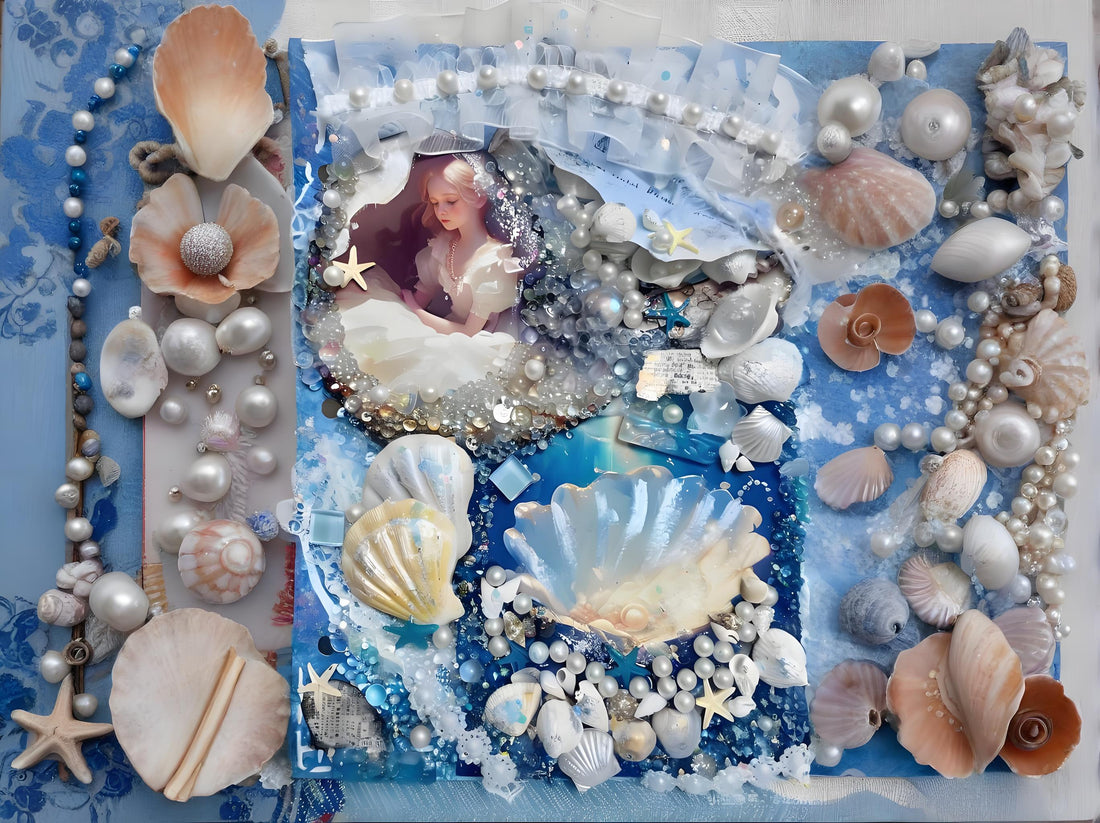Overview at a glance
Idea → Artwork → Prepress → Materials → Printing → Finishing → QC → Packing & Shipping.
Stickers and washi follow the same arc, but the “prepress” and “finishing” steps differ in important ways (kiss-cuts for stickers; repeats/slitting/rewinding for washi).
1) Concept & Artwork: where your brand voice is born
Start with a tight brief. Define: audience, vibe (e.g., “soft vintage,” “Alice dreamland”), color universe, and use cases (journals, laptops, water bottles, pen barrels).
Build the art system.
-
Vectors for edges; rasters for texture.
Use vector paths for sticker outlines and delicate line art; use high-res rasters (≥300–600 dpi at print size) for watercolor and grain. -
Color models. Design in CMYK if you know you’ll print; keep a master RGB file for web. Assign an ICC profile and note it in your handoff.
-
Special layers. Name extras clearly:
-
DIELINE_KISS(sticker cut) -
SAFE_AREA -
WHITE_INK(for clear, silver, or holographic films) -
FOIL_GOLD,SPOT_UV,GLOW, etc.
-
-
Legibility rules. Minimum line weight ~0.2–0.3 mm; small text ≥5–6 pt on paper, ≥6–7 pt on textured washi.
Two creative layouts to consider
-
Sticker sheets: grid or “scatter” compositions; plan negative space so tweezer-picking is easy.
-
Washi tiles: design a seamless tile (the art that repeats around the roll); hide the seam with a leaf, ribbon, or cloud.
Pro tip: Keep black rich but safe for CMYK (e.g., C60 M40 Y40 K100 for deep elements; use 100%K only for hairline text to avoid mis-registration).
2) Prepress: turning art into something a machine understands
Bleed & safety.
-
Stickers: 2–3 mm bleed beyond the cut; keep critical details ≥2 mm inside the cut path.
-
Washi: extend pattern past tile edges and “feather” colors so the seam is invisible.
Dielines & repeats.
-
Stickers: one path per shape (kiss-cut). For sheet sets, also create an outer
THROUGH_CUTif you want the whole sheet to snap out. -
Washi: confirm width (commonly 5/10/15/20/30 mm), roll length (often 5–10 m), core (1" or 3"), and unwind direction. Tile length varies by factory—share your desired repeat (e.g., ~350–400 mm) and let them match cylinders.
Color targets. Provide Pantone bridges or printed targets if color fidelity matters; agree on acceptable variance (e.g., ΔE ≤ 3–4 for hero tones).
File delivery checklist
-
Outlines expanded, fonts converted to curves
-
Linked images embedded at 300–600 dpi
-
Spot layers named and set to “overprint” where appropriate
-
One PDF/X export per SKU, plus the open files (AI/PSD)
3) Materials: how your product feels, tears, and sticks
Sticker face stocks (choose the character you want)
| Face stock | Look & feel | Pros | Watch-outs |
|---|---|---|---|
| Art paper (matte/gloss) | Paper-y, writable | Budget-friendly, sharp detail | Not fully waterproof unless laminated |
| Vinyl (PVC-free PP/PET preferred) | Smooth, durable | Waterproof, outdoor-friendly | Can look “plastic” if over-glossed |
| Clear film | See-through edges | Great with WHITE_INK underprint | Dust and fingerprints show |
| Holographic/foil base | Rainbow flash | Instant “wow” | Needs careful white/spot masking |
Adhesives: permanent, removable, or repositionable acrylics. Tell the factory your surfaces (paper, plastic cases, glass) and whether you want clean removal.
Lamination/Varnish: matte (soft, anti-glare), gloss (color pop), satin, soft-touch, glitter, or spot UV accents. Laminate boosts water/scuff resistance.
Washi tape (the cult favorite)
-
Substrate: traditional washi (Japanese-style paper fibers) gives that soft, tear-by-hand charm and semi-transparency.
-
Ink system: usually water-based or gravure inks for smooth laydown and subtle blends.
-
Adhesive: low-tack acrylic—should lift cleanly from journal paper without tearing fibers.
Sustainability notes: ask for FSC-certified papers, solvent-free adhesives, and PVC-free films; request RoHS/REACH/CPSIA statements if you sell to kids/US schools.
4) Printing: matching method to your MOQ, budget, and effect
-
Digital (HP Indigo / UV inkjet / water-based inkjet): low MOQs, fast turn, excellent for many SKUs and color-rich art.
-
Flexography: plate-based, efficient for medium-to-large runs; good with spot colors, foils, and varnish effects.
-
Gravure (common for washi): engraved cylinders deliver buttery gradients and metallics across long runs with consistent color.
-
Screen printing (selective): thick, opaque layers—great for white ink on clear/holo or special textures.
Factory conversation starters
-
What line screen/plate count for my art?
-
Is underprint white needed on X areas?
-
Recommended trapping (0.1–0.2 mm) for adjacent colors?
5) Finishing: where the “feel” is finalized
Stickers
-
Print on chosen face stock + adhesive + release liner.
-
Laminate or varnish (optional but recommended for durability).
-
Die-cutting:
-
Kiss-cut (through face stock, not liner) for peel-off shapes.
-
Through-cut for individual pieces.
-
-
Weeding (removing waste), sheeting or rewinding into rolls.
Washi tape
-
Print your seamless tile on the wide web.
-
Optional finish: matte/satin clear coat for rub resistance.
-
Slitting: the web is slit into final widths (e.g., 15 mm).
-
Rewinding: onto cores at the specified length; apply belly bands or wrap.
6) Quality Control: protect your art (and your reviews)
-
Color: compare to your approved proof; set ΔE tolerance.
-
Registration: edges and small text should be crisp with no color halos.
-
Adhesion & removability (stickers/washi): test on coated and uncoated paper; should hold flat but lift cleanly if that’s the spec.
-
Abrasion & water: rub test after 24 h cure; mist test for inkfastness; check lamination integrity.
-
Cut accuracy: measure off the dieline; typical tolerance is ±0.3–0.5 mm.
-
Washi seam: the repeat join should be invisible at normal viewing distance.
Keep a “golden sample” (signed, dated) and ask the factory to keep one too. It’s your standard for reorders.
7) Packaging & Compliance: the unboxing moment
-
Sticker sheets: opp sleeves with a branded backer card; add SKU, barcode, material, and care icons.
-
Individual die-cuts: little glassine envelopes or kiss-cut mini-sheets—cute and shippable.
-
Washi: shrink-wrap or paper belly band + core label (SKU, width×length, finish).
-
Regulatory: if marketed to children, confirm CPSIA tracking labels and heavy-metal limits; include choking hazard labels for small packs where needed.
8) Timelines, MOQs & Cost levers
-
Design & prepress: as long as you need—this is where problems are cheapest to solve.
-
Digital runs: fastest, higher unit cost, minimal MOQs—ideal for limited editions or market tests.
-
Plate/cylinder methods (flexo/gravure): longer lead (plates/cylinders), lower unit cost at scale.
-
Cost levers: simplify SKUs, reduce foil/spot operations, standardize sizes (e.g., 15 mm × 10 m washi), gang-run sticker sheets.
9) Maker’s Handoff: the spec sheet your factory will love
For stickers
-
Size(s) & shapes; sheet layout or roll; outer through-cut yes/no
-
Face stock (paper/vinyl/clear/holo), adhesive (perm/removable)
-
Finish (matte/gloss/satin/soft-touch/spot UV/foil)
-
Cut tolerance target; backside print yes/no
-
File package: print PDF + open files; list of spot layers
For washi
-
Width, roll length, core size, unwind direction
-
Tile length target; note if edge-to-edge art or with borders
-
Finish (raw/matte coat/satin), seam-hiding element location
-
Core and outer labeling requirements; packaging style
10) Common pitfalls (and how to dodge them)
-
No bleed / too-tight art: build 2–3 mm safety; extend backgrounds.
-
Forgetting white ink on clear/holo: define a
WHITE_INKspot layer. -
Hairline text on textured washi: bump size or thicken strokes.
-
RGB surprises at press: work CMYK or provide Pantone anchors.
-
Washi seam popping: design a “seam camouflage” motif and feather gradients across the join.
-
Over-gloss on pastel art: consider matte or satin so colors stay gentle.
Glossary (quick refresher)
-
Bleed: extra image beyond the cut to avoid white edges.
-
Kiss-cut: cuts the sticker face, not the liner.
-
Through-cut: cuts through face + liner (individual pieces).
-
Tile (washi): the repeating art section that forms the roll.
-
ΔE: numerical color difference; lower is closer.
-
Unwind direction: the way the design faces as the tape unrolls.
Final thought
The best stationery feels effortless because every production choice was deliberate. If you treat prepress as design, speak the same language as your factory, and keep a clean spec sheet, your stickers will peel like butter and your washi will roll with that signature, soft-tear joy. Happy making—and may your next run be your cleanest yet.

